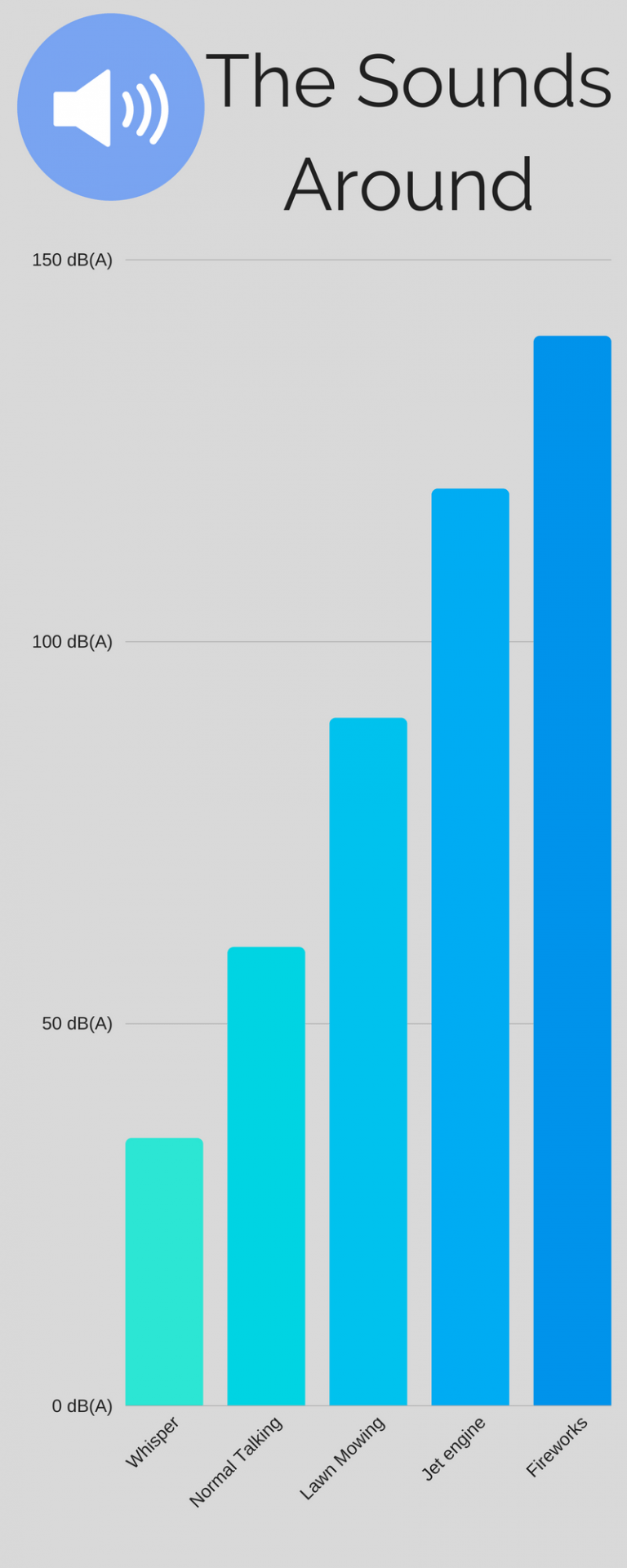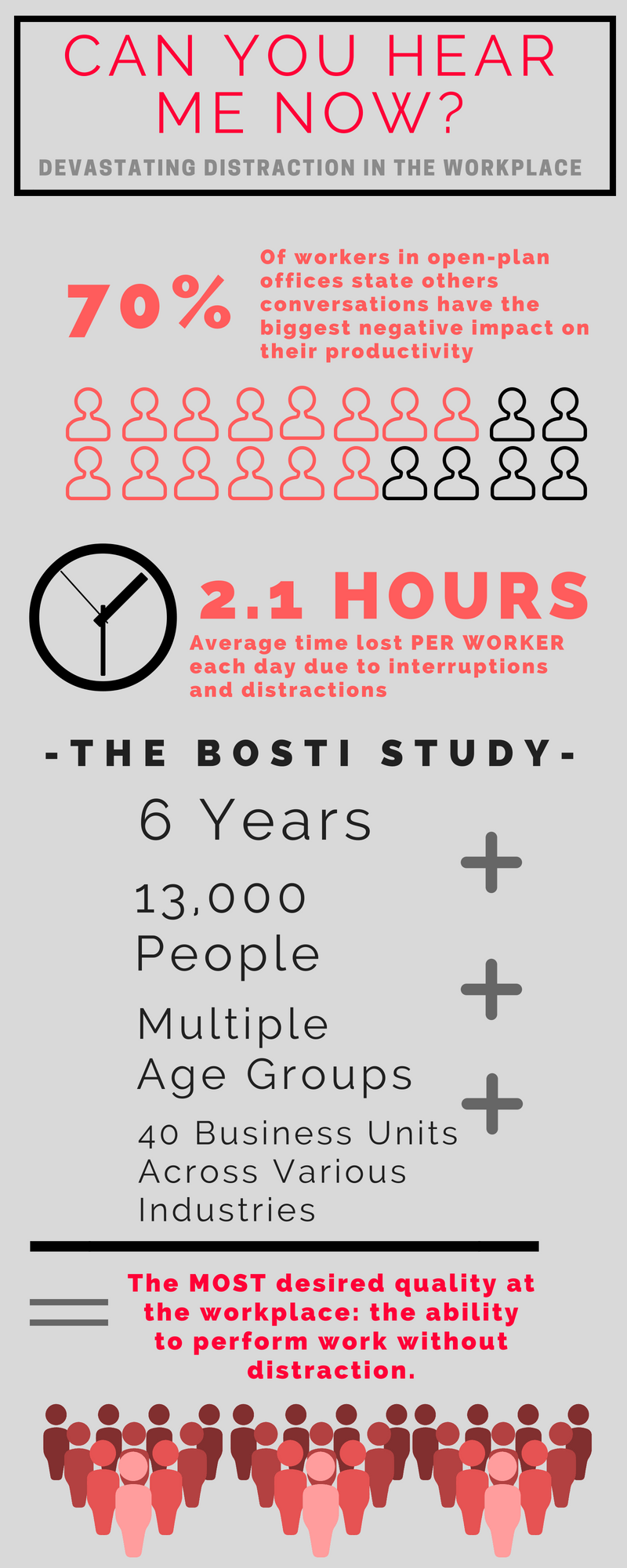Today’s workplaces are constantly being overhauled to optimize productivity. Open concept layouts, creative seating solutions, pull up desks, natural lighting, and biophilic designs are all being utilized in order to make offices more comfortable, more productive, and ultimately more profitable. We know that the air we breathe, the light we see, and the furniture we feel have all proven to be essential to employee efficiency. But what about our other sense – what we hear? Does it do any good to have great lighting, quality air, etc. if we’re constantly being bombarded with rings, dings, chatter, mowers, and horns?
Privacy and productivity go hand-in-hand with acoustic sound quality in the workplace. Noise and sound can be differentiated by defining noise as unwanted sound. Examples of noise in the workplace include:
- Overhearing conversations, both by individuals and groups
- Environmental background sounds like air vents, outside noises, music
- Workspaces in high traffic areas or near break rooms
⇒ Additionally, backgrounds can be too quiet, causing any sound to stand out and distract.

Privacy and sound are intrinsically connected. Employees at all levels need to feel secure in their environments and conversation confidentiality plays a big part in that. The ability to have a private conversation and conversely not inadvertently overhear the conversations of others is highly important in the workplace. In fact, 70% of employees in an open office state that the conversations of others have the biggest negative impact on their creativity.
Two forces driving a push towards better sound quality in workplace design are increasing shifts towards open-plan office spaces and further emphasis on group teamwork and collaboration. While group work has proven to be a highly productive tool within the modern workplace, an unfortunate side effect has been decreased sound quality and increased noise. As groups gather and collaborate, the decibels rise and distraction ensues. There is even a scientific name for this: the Lombard effect.
The Lombard effect is the involuntary tendency of speakers to increase their vocal effort when speaking in loud noise to enhance the audibility of their voice.
In other words, people naturally increase their speaking volume more and more as their surroundings get louder. In general, a group can quickly become very loud as each speaker tries to talk more and more loudly. Interestingly, the Lombard effect doesn’t just relate to decibels but also to other sound features such as pitch, rate, and duration of syllables. Open floor plans and group collaboration in the workplace aren’t going anywhere thanks to their incredible ability to increase productivity – so increased attention has been put on acoustic quality to negate the distracting side-effects of such situations.
In the past, simplistic design tools were utilized to create a better sound environment in throughout workplaces. Office designers utilized elements likes carpet, fiber ceiling tiles, and high partitioned workstations for privacy and noise reduction. While effective for their time, acoustic design elements have now evolved into more advanced tools to fight nasty noise and increase sound design quality. Materials like cutting-edge fabrics and perforated timbers and metals have emerged that can be cut and colored to nearly any specification and then utilized to drastically reduce noise influence from the outside AND absorb sounds from the inside. Designers see a future where acoustic products will be seamlessly integrated into workspaces in a variety of forms so it won’t even be obvious that they’re there as acoustic boosters. These advanced acoustic materials will become panels, ceiling baffles, furniture, signage, desk barriers, walls, and even art.
For designers, acoustic quality is a challenge and an opportunity. Acoustic expert Angus Blaiklock tells us
“there are so few surfaces left in a workplace today – the biggest challenge is how to incorporate noise absorptive products without it being too obvious that is what is happening”.
In addition, the design community itself was initially slow to fully recognize the importance of acoustic quality.
“I think the design community’s consciousness about the benefits of an acoustically designed space has improved dramatically. There is still a long way to go, but it is always a tough dynamic between achieving the design aesthetic the client is after as well as an appropriately acoustically designed fit-out”, says Blaiklock.
As designers and workplaces continue to evolve in the ever-increasing fast pace of today’s business world, the correlation between privacy, job satisfaction, and job performance will also continue to be recognized. Buzzwords like architectural privacy as it relates to acoustic qualities will be factored into workplaces at every level. As more and more studies reveal, there exists a positive relationship between job productivity and performance, and privacy and thoughtful sound design.
“As design and fashion move so does technology and the perceived best solutions for the most appropriate design for an office. In some design thinking, there has been a move away from the open office – as such, noise reduction products/solutions will continue to develop”. – Angus Blaiklock
Special thank you to acoustic expert Angus Blaiklock for contributing to this Nevins post.

References:
- Wallis, Steptoe, & Cole, 2006
- Brill, Weidemann, & BOSTI Associates, 2001
- Burt R. E., Sundstrom E. Workspace and job satisfaction: Extending equity theory to the physical environment, Paper presented at the annual conference of the American Psychological Association, New York, September 1979.
- https://www.certainteed.com/resources/142926011-Office-Acoustics-Infographic.pdf
- https://en.wikipedia.org/wiki/Lombard_effect
- Kupritz & Haworth, Inc., 2005

Social Media Coordinator
